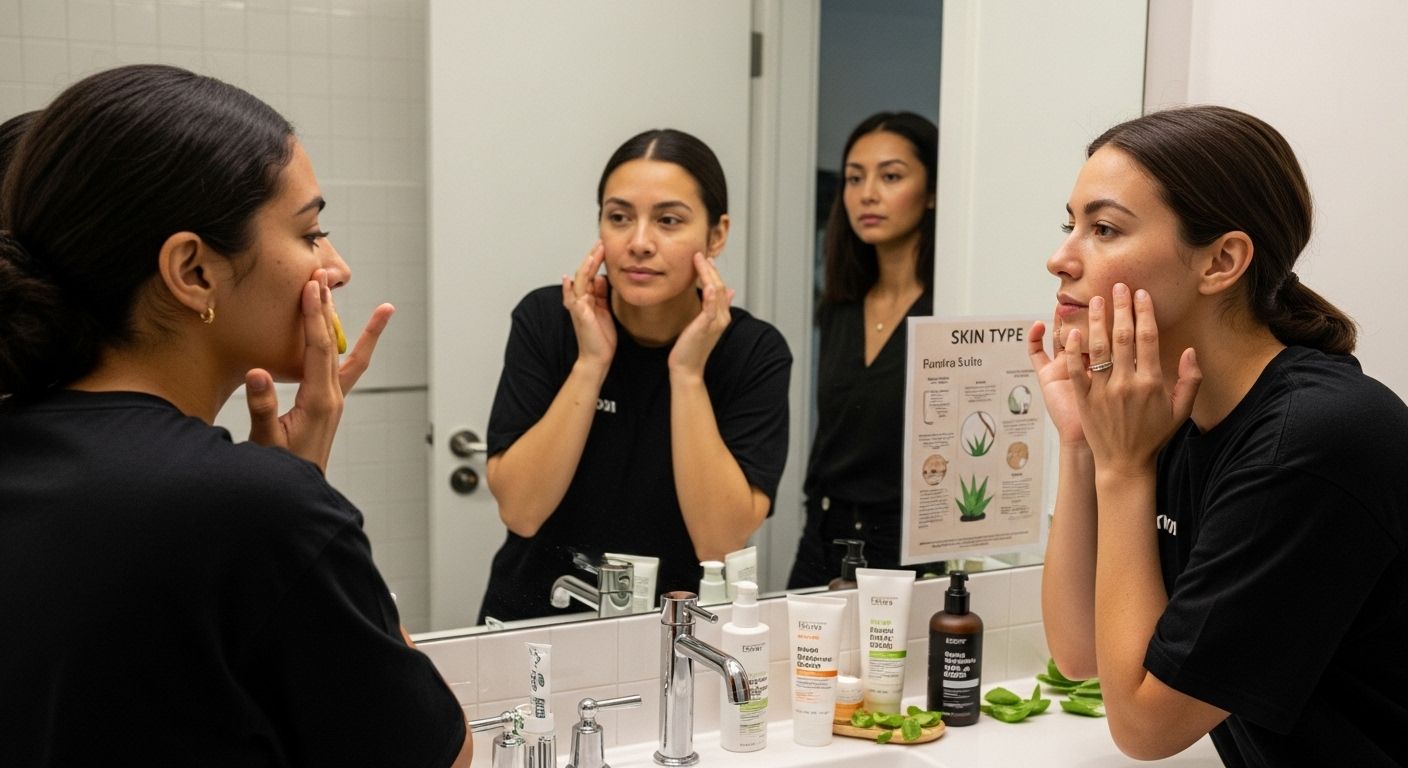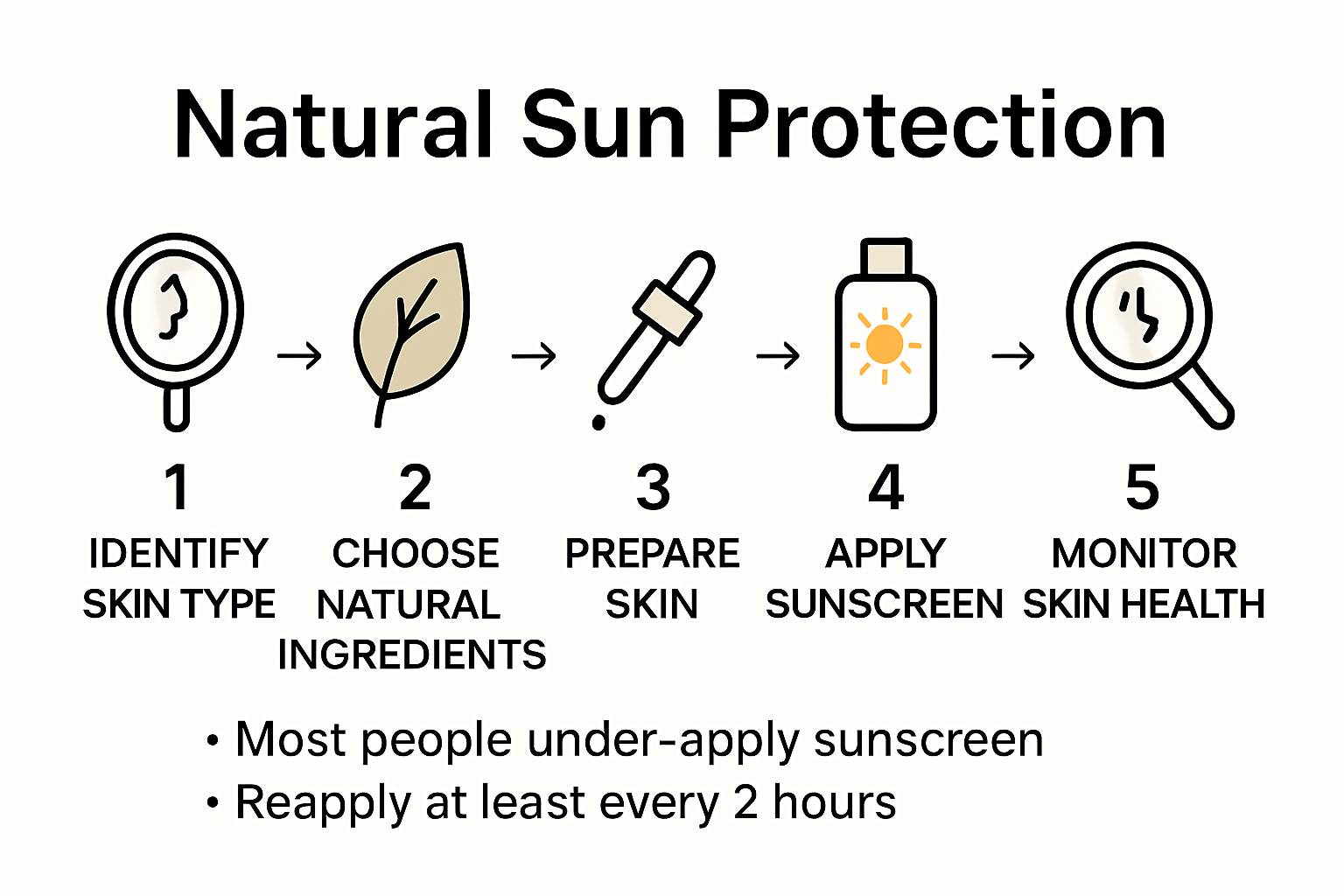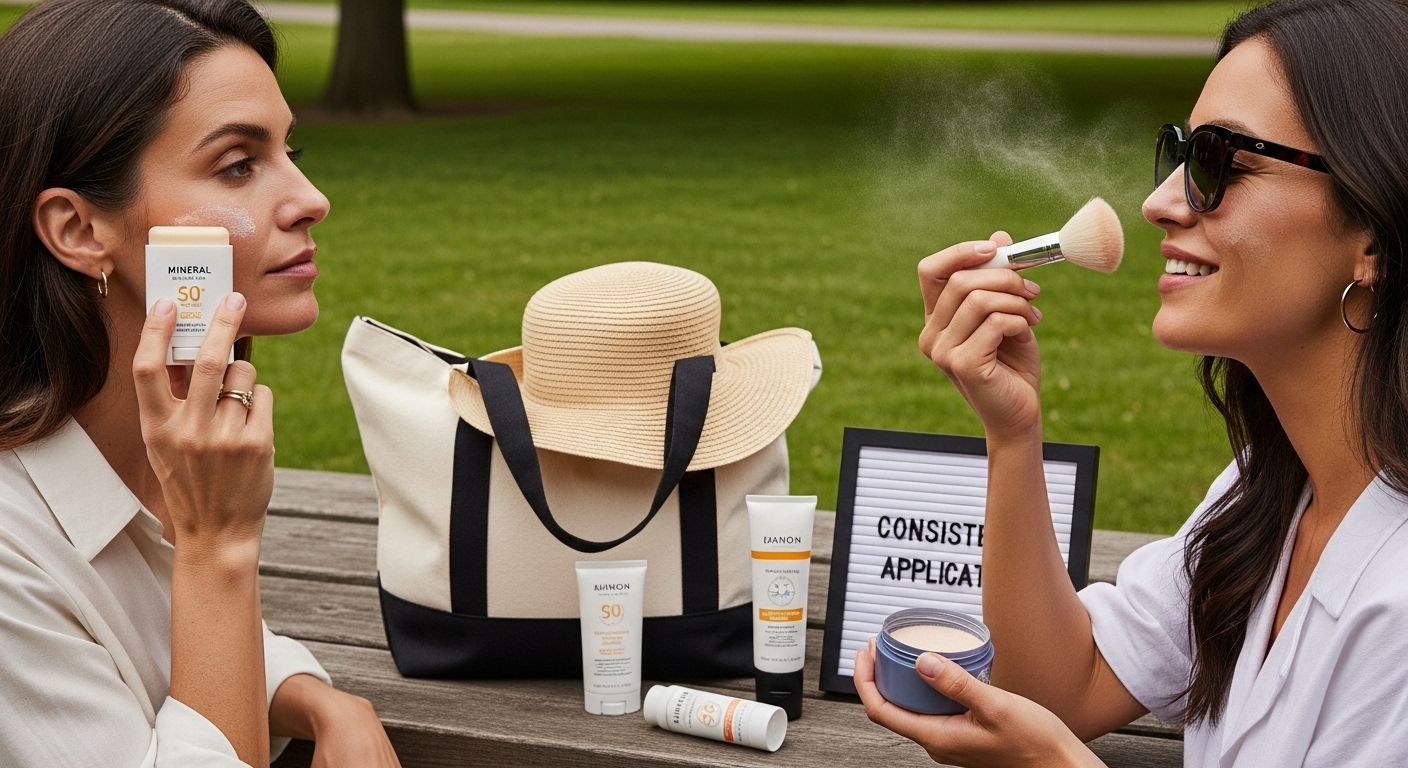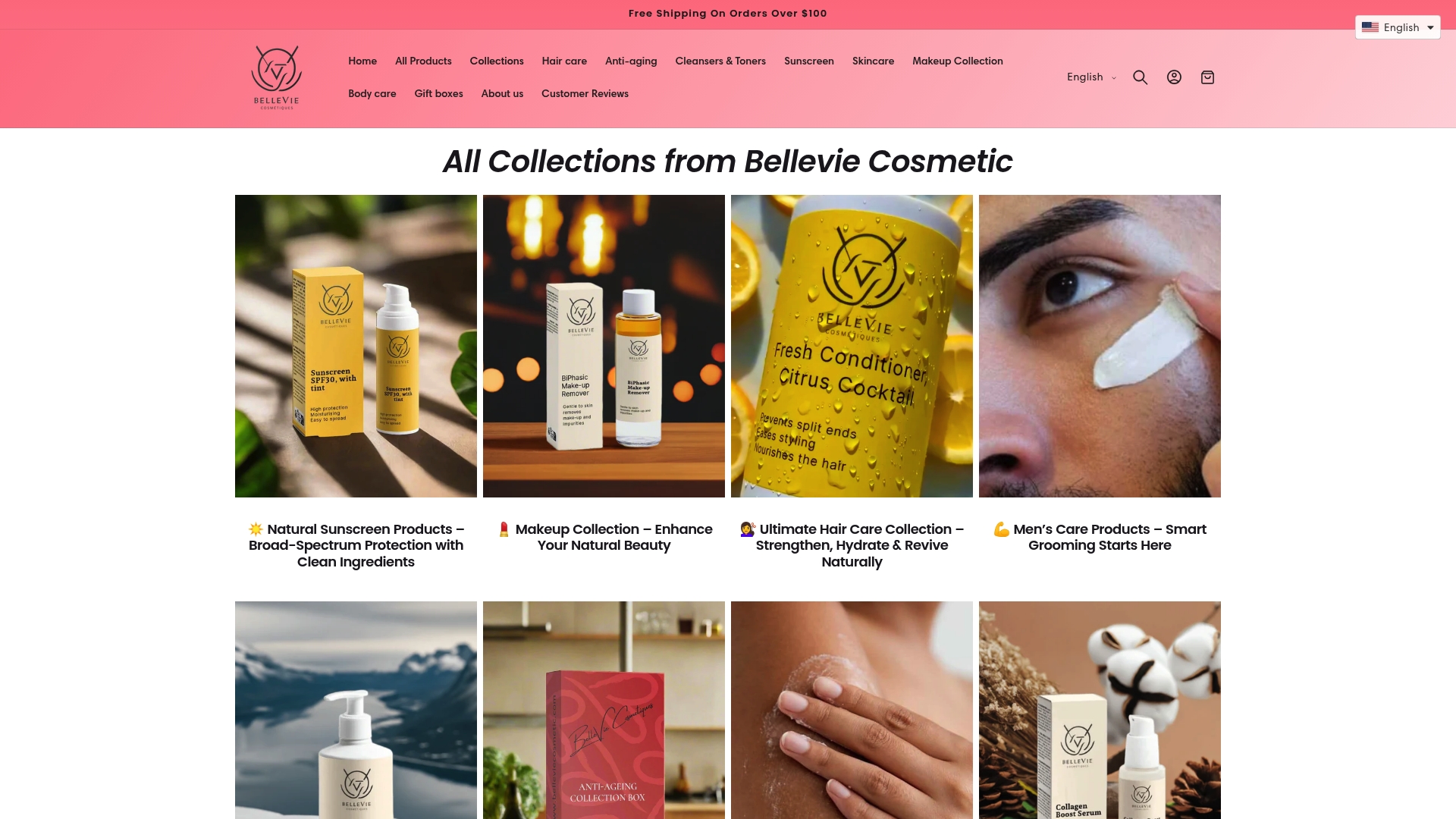Picking a sunscreen sounds simple, but protecting your skin goes way beyond that. Most people do not realize that using only 25-50 percent of the recommended sunscreen drastically cuts its protection. Surprised? That is not even the most important step. Identifying your exact skin type is what makes or breaks your sun care routine and sets up your skin for real, lasting defense.

Table of Contents
- Step 1: Identify Your Skin Type For Tailored Protection
- Step 2: Choose Natural Ingredients For Sun Protection
- Step 3: Prepare Your Skin With Pre-Sun Application
- Step 4: Apply Natural Sun Protection Consistently
- Step 5: Monitor Your Skin And Adjust As Needed
Quick Summary
| Key Point | Explanation |
|---|---|
| 1. Identify Your Skin Type | Knowing your skin type helps select suitable sun protection strategies tailored to your unique needs. |
| 2. Choose Effective Natural Ingredients | Prioritize mineral sunscreens like zinc oxide and titanium dioxide combined with antioxidant-rich botanical extracts for optimal protection. |
| 3. Prepare Your Skin Before Sun Exposure | Cleanse and hydrate skin before applying sunscreen to enhance its natural defenses against UV damage. |
| 4. Apply Sunscreen Consistently | Establish a regular routine for sunscreen application, reapplying every two hours to maintain protection against sun exposure. |
| 5. Monitor Your Skin’s Response | Regularly assess your skin’s condition and reactions to adjust sun protection strategies, ensuring long-term skin health. |

Step 1: Identify Your Skin Type for Tailored Protection
Protecting your skin from sun damage starts with understanding your unique skin type. Knowing whether you have dry, oily, combination, sensitive, or normal skin will help you select the most effective natural sun protection strategies. Your skin type influences how it responds to sunlight, environmental stressors, and specific protective ingredients.
To accurately determine your skin type, begin with a simple at-home assessment. Cleanse your face thoroughly with a gentle cleanser and wait approximately one hour without applying any products. During this time, observe how your skin feels and looks. Oily skin will appear shiny and feel greasy across the forehead, nose, and chin. Dry skin will feel tight, potentially showing small flakes or rough patches. Combination skin typically presents as oily in the T-zone (forehead, nose, chin) while remaining normal or dry on cheeks.
Sensitive skin requires special consideration when selecting natural sun protection. If you experience frequent redness, irritation, or quick reactions to new skincare products, your skin falls into the sensitive category. For these skin types, mineral-based sunscreens with zinc oxide or titanium dioxide are typically the safest and most gentle options. Look for products with soothing natural ingredients like aloe vera, chamomile, and green tea extract, which provide additional calming benefits while protecting against UV radiation.
After identifying your skin type, you can more effectively choose natural sun protection methods that complement your skin’s specific needs. Those with oily skin might prefer lightweight, non-comedogenic sunscreen options, while individuals with dry skin should seek hydrating formulations that offer both moisture and protection. The goal is to create a personalized sun protection routine that feels comfortable and supports your skin’s overall health.
Verify your skin type assessment by consulting with a dermatologist or skincare professional who can provide more detailed insights. This step ensures you’re using the most appropriate natural sun protection techniques for your unique skin characteristics.
Below is a table summarizing different skin types and suitable natural sun protection approaches tailored to each. This helps readers quickly match their skin characteristics with recommended strategies.
| Skin Type | Key Characteristics | Recommended Natural Protection |
|---|---|---|
| Oily | Shiny, greasy forehead, nose, chin | Lightweight, non-comedogenic mineral sunscreen |
| Dry | Tightness, flaking, rough patches | Hydrating mineral sunscreens with aloe vera |
| Combination | Oily T-zone, normal/dry cheeks | Balanced formula, mineral sunscreen |
| Sensitive | Redness, irritation, quick reactions | Zinc oxide/titanium dioxide; soothing botanicals |
| Normal | Balanced, neither oily nor dry | Gentle mineral sunscreen, basic botanical extracts |
Step 2: Choose Natural Ingredients for Sun Protection
Natural sun protection goes beyond simply applying a product - it involves selecting powerful botanical ingredients that offer comprehensive skin defense against harmful UV radiation. Understanding which natural components provide the most effective protection can transform your skincare routine and support long-term skin health.
Zinc oxide and titanium dioxide emerge as premier natural mineral sunscreens that physically block ultraviolet rays. These naturally occurring minerals create a protective barrier on your skin, reflecting and scattering sunlight before it penetrates deeper layers. When searching for natural sun protection, prioritize products containing these minerals, as they provide broad-spectrum protection without introducing potentially harmful chemical compounds.
Botanical extracts play a crucial role in enhancing your skin’s natural defense mechanisms. Green tea extract, rich in polyphenols, offers remarkable antioxidant properties that help neutralize free radicals generated by sun exposure. Aloe vera provides additional soothing benefits, helping to calm and repair skin while offering mild protective qualities. Other potent natural ingredients like red raspberry seed oil and carrot seed oil contain inherent SPF properties and provide extra nourishment during sun exposure.
Compiling a natural sun protection arsenal requires strategic ingredient selection. Look for products that combine mineral shields like zinc oxide with antioxidant-rich botanical extracts. Some key ingredients to seek out include:
- Zinc oxide
- Titanium dioxide
- Green tea extract
- Aloe vera
- Red raspberry seed oil
- Carrot seed oil
- Vitamin E
As recommended by research from the National Institutes of Health, these natural compounds offer multi-layered protection by not only blocking UV rays but also supporting your skin’s intrinsic repair and defense mechanisms. Verify the effectiveness of your chosen natural sun protection by observing how your skin responds - reduced redness, minimal irritation, and maintained moisture levels indicate a successful approach to sun defense.
Step 3: Prepare Your Skin with Pre-Sun Application
Preparing your skin before sun exposure is a critical step in natural sun protection that goes beyond simply applying sunscreen. This proactive approach involves creating a protective foundation that strengthens your skin’s natural defense mechanisms and enhances its resilience against potential UV damage.
Begin by thoroughly cleansing your skin to remove any dirt, oil, or residual products that might interfere with sun protection. Use a gentle, natural cleanser that won’t strip your skin of its protective barrier. Hydration plays a crucial role in preparing your skin for sun exposure, so follow cleansing with a lightweight, antioxidant-rich moisturizer that supports your skin’s natural protective functions.
Antioxidant serums provide an additional layer of defense before sun exposure. Look for formulations containing vitamin C, vitamin E, or green tea extract, which help neutralize free radicals and provide an extra shield against environmental damage. Apply these serums to clean skin, allowing them to absorb completely before moving to the next step of your sun protection routine. These powerful natural ingredients work beneath the surface to strengthen your skin’s inherent protective capabilities.
Key pre-sun application steps include:
- Gentle natural cleansing
- Hydrating moisturizer application
- Antioxidant serum protection
- Thorough sunscreen coverage
- Lip and eye area special attention
As recommended by the Centers for Disease Control and Prevention, applying sunscreen should be the final step in your pre-sun preparation. Choose a broad-spectrum mineral sunscreen with at least SPF 15, ensuring complete and even coverage. Pay special attention to often-overlooked areas like ears, neck, and the backs of hands. Reapply every two hours or immediately after swimming or excessive sweating.
Verify your pre-sun preparation by checking for even coverage, no missed spots, and a comfortable, non-greasy feeling. Your skin should feel protected, hydrated, and ready to face sun exposure with enhanced natural defense mechanisms. Remember that proper preparation is your first line of defense against potential sun damage.
Step 4: Apply Natural Sun Protection Consistently
Consistent application of natural sun protection is the cornerstone of maintaining healthy skin and preventing long-term UV damage. Frequency and thoroughness are key elements that transform sun protection from a sporadic activity into a reliable daily ritual that safeguards your skin’s health and appearance.
Establish a systematic approach to sunscreen application by making it an integral part of your morning routine. Immediately after moisturizing, apply your natural mineral sunscreen generously, ensuring complete coverage of all exposed skin areas. Pay special attention to commonly overlooked regions such as the back of the neck, ears, tops of feet, and hands. Most individuals dramatically under-apply sunscreen, using only 25-50% of the recommended amount, which significantly reduces its protective capabilities.
Reapplication is crucial for maintaining continuous protection throughout the day. Set reminders to reapply your natural sunscreen every two hours, or more frequently if you’re swimming, sweating, or engaging in outdoor activities. Carry a travel-sized natural sunscreen in your bag or car to make reapplication convenient. Consider using powder mineral sunscreens for quick touch-ups, which can be easily applied over makeup or during midday sun exposure without disrupting your existing skincare routine.
Key consistent application strategies include:
- Apply sunscreen 15-30 minutes before sun exposure
- Use approximately one ounce (shot glass full) for full body coverage
- Reapply every two hours
- Use additional protection like hats and protective clothing
- Check expiration dates on natural sunscreen products
As recommended by recent research, consistent use of natural sunscreens with antioxidant properties provides comprehensive protection against UV-induced skin damage. Verify the effectiveness of your application by checking for even coverage, no missed spots, and a comfortable, non-greasy feeling. Your skin should appear evenly protected, with no areas of redness or unprotected skin visible.
Remember that natural sun protection is a daily commitment, not just a beach day necessity. By making consistent application a non-negotiable part of your skincare routine, you’re investing in your skin’s long-term health and preventing premature aging and potential sun damage.
This checklist table helps you verify whether you are following all crucial steps in your natural sun protection routine, as recommended throughout the article. Refer to this regularly for optimal results.
| Step | Verification Criteria |
|---|---|
| Identify skin type | Know your skin type and choose matching sun protection |
| Select natural sun protection ingredients | Product includes zinc oxide/titanium dioxide and botanicals |
| Prepare skin before sun exposure | Skin is clean, hydrated, with antioxidant serum applied |
| Thorough sunscreen application | Even coverage, all areas protected, non-greasy feeling |
| Consistent reapplication | Sunscreen reapplied every two hours/outdoor activity |
| Monitor and adjust routine | Skin checked for changes, adjustments made as needed |

Step 5: Monitor Your Skin and Adjust as Needed
Monitoring your skin’s response to natural sun protection is a dynamic process that requires careful observation and proactive adaptation. Your skin is constantly changing, influenced by factors like age, hormones, environmental conditions, and overall health. Developing a keen understanding of how your skin reacts to sun exposure will help you refine your protection strategy and maintain optimal skin health.
Begin by conducting a comprehensive monthly skin assessment. Examine your skin carefully in natural light, looking for subtle changes such as new freckles, changes in existing moles, uneven pigmentation, or signs of sun damage like fine lines and texture variations. Use a handheld mirror to check hard-to-see areas like the back of the neck, ears, and shoulders. Take clear, well-lit photographs to track changes over time, which can help you identify patterns and potential concerns more objectively.
Pay special attention to how your skin responds to different natural sun protection products and techniques. Some individuals might experience increased sensitivity or mild reactions to certain mineral-based sunscreens or botanical ingredients. Keep a detailed skincare journal documenting the products you use, sun exposure duration, and any skin changes or reactions. This record will help you identify which natural ingredients work best for your unique skin type and which might require adjustment.
Key skin monitoring strategies include:
- Perform monthly skin self-examinations
- Track changes in moles, freckles, and pigmentation
- Note skin sensitivity and product reactions
- Consult a dermatologist annually
- Adjust sun protection based on seasonal changes
- Update your sun protection routine as your skin evolves
Consider scheduling an annual professional skin assessment with a dermatologist who can provide expert insights into your skin’s health and help you identify any potential early signs of sun damage. Professional screenings are particularly important for individuals with fair skin, a history of sunburns, or a family history of skin cancer.
Verify the effectiveness of your monitoring by ensuring you can confidently describe your skin’s current condition, recognize any new or changing skin features, and feel empowered to make informed adjustments to your natural sun protection routine. Remember that skin protection is an ongoing journey of observation, learning, and adaptation.
Nurture Your Skin with Proven Natural Protection
You have learned how identifying your skin type and choosing the right natural ingredients are essential for genuine sun protection. Still, finding high-quality sun care that supports your goals can be challenging. Many struggle with sunscreen that leaves a white cast, irritates sensitive skin, or never feels quite right for their unique complexion.
At BelleVieCosmetic.com, we offer science-backed, EU-crafted products made specifically for real people with real skin. Whether you have oily, dry, sensitive, or combination skin, our award-winning SPF50 mineral sunscreen stick delivers broad protection without harsh chemicals or that unwanted residue. You can build your own complete routine with our natural cleansers and moisturizers, all designed to layer seamlessly and keep your skin healthy before, during, and after sun exposure.

Ready to take your sun protection to the next level? Explore our full collection of natural skincare solutions right now. Act today to unlock fast shipping and receive a free $25 skincare gift when you subscribe and spend $60. Start protecting your skin the clean, effective way and see the results for yourself.
Frequently Asked Questions
How do I determine my skin type for natural sun protection?
To determine your skin type, cleanse your face and wait for an hour without applying any products. Observe how your skin feels: oily skin appears shiny, dry skin feels tight, and combination skin shows different characteristics in the T-zone and cheeks. Sensitive skin may react quickly to new products.
What natural ingredients should I look for in sunscreens?
Look for mineral-based ingredients like zinc oxide and titanium dioxide, as well as botanical extracts such as green tea, aloe vera, red raspberry seed oil, and carrot seed oil. These ingredients provide effective UV protection and support skin health with antioxidants.
How can I prepare my skin before sun exposure?
Before sun exposure, cleanse your skin, apply a hydrating moisturizer, and use an antioxidant serum containing ingredients like vitamin C or E. Finish with a broad-spectrum mineral sunscreen to ensure comprehensive protection from UV damage.
How often should I reapply natural sunscreen?
Reapply your natural sunscreen every two hours, especially after swimming or sweating. It’s essential to ensure consistent protection throughout the day. Using a travel-sized sunscreen or powder mineral sunscreen can make reapplication more convenient.
💬 Looking for safe and natural ways to protect your skin from the sun?
Chat directly with our AI Skincare Advisor on Instagram and get personalized sun care tips and product recommendations.
